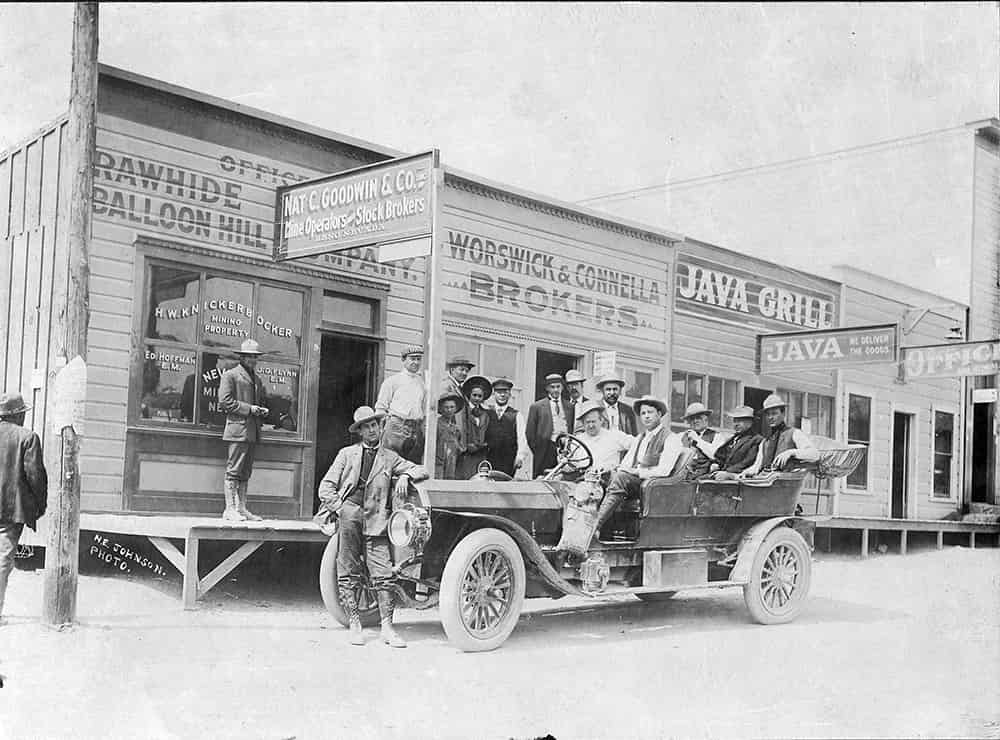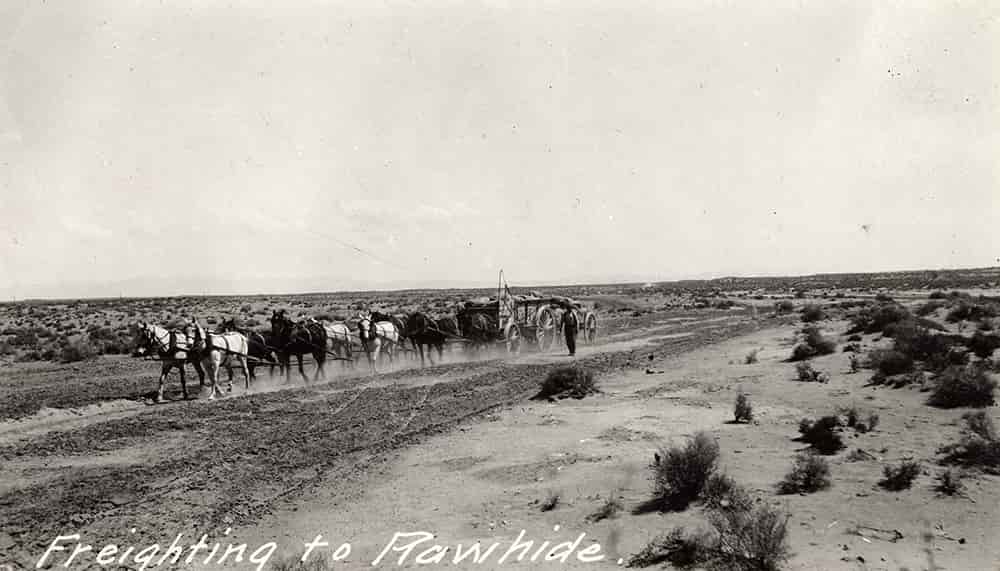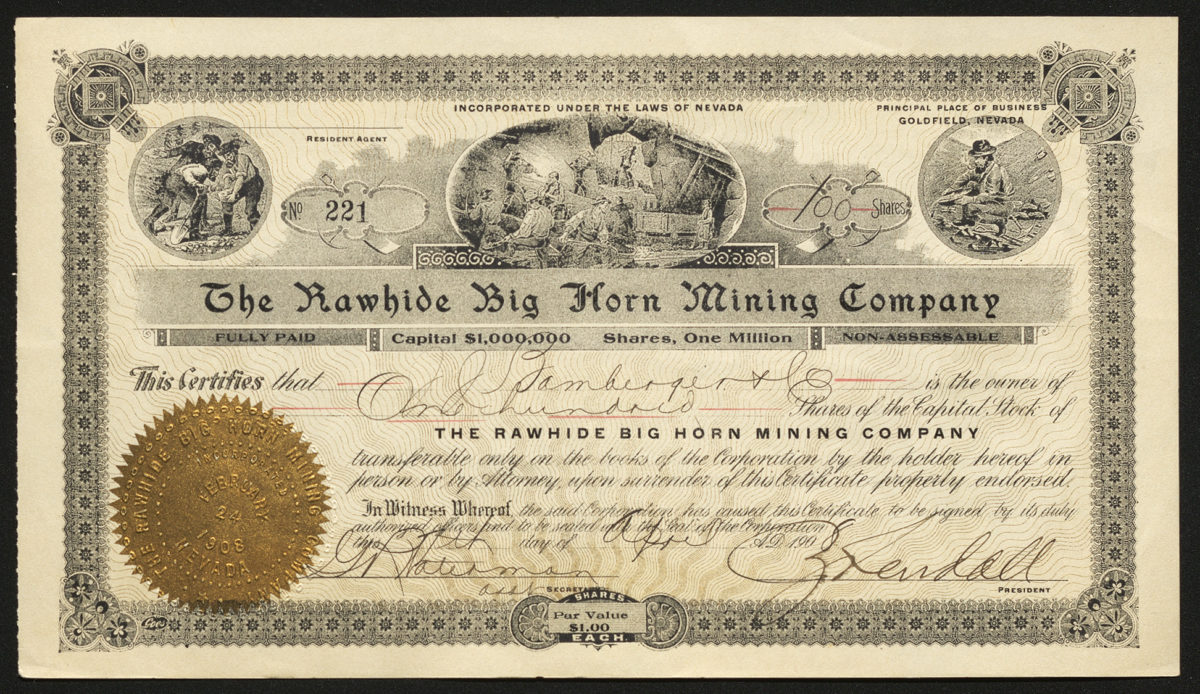
Rawhide and the Era of Boosterism
George Graham Rice made a career out of swindling east-coast investors and promoted Rawhide as the next big mining boom in Nevada. The mines ultimately proved to be unimpressive, and the town is better remembered for Rice’s antics.
Header Image: Men in Rawhide; the man behind the steering wheel is likely Nat C. Goodwin, Rice’s accomplice in the Elinor Glyn stunt; courtesy Special Collections Department, University of Nevada, Reno Libraries [1].
“Only a hair-brained enthusiast of the wild-eyed order could hope at such a time possibly to succeed in the marketing of new mining issues.”

A freight team brings supplies to Rawhide, ca. 1907; courtesy Special Collections Department, University of Nevada, Reno Libraries
Rawhide, Nevada was a mining camp north east of Walker Lake founded in 1907 after the discovery of gold and silver in the area led to a short mining boom. Rawhide is a good example of boosterism in western mining towns. New mining camps were heavily promoted to attract investments, although many of them never produced significant quantities or qualities of ore; investors gambled that this might be the next big strike.
Some unsavory characters took advantage of this, using boosterism to sell east-coast investors stock in mines with low-grade ore, and at times even ‘salting’ barren mines with high-grade ore to trick assayers. As author Robert Greenwood describes of Rawhide: “The assay reports were grossly exaggerated, however, more promotional than real. Newspapers in Goldfield and Tonopah publicized the discoveries, copied by the eastern press. Everyone who had missed the boom at Tonopah and Goldfield saw this as a second chance to get in on the ground floor of a new bonanza.”
Infamous mining stock swindler George Graham Rice promoted Rawhide to inflate stock prices. He famously orchestrated the theatrics surrounding writer Elinor Glyn’s visit to the mining camp. Rice and accomplices staged a poker-table shoot out—complete with the ‘bodies’ of the miners carried away to the undertaker on stretchers—took Glyn to view the brothels and dance halls, and even set fire to the town. All of these efforts proved to be opportunities for free publicity for the fledgling mining camp, as reporters chronicling Mrs. Glyn’s sensational adventures nationally spread word of the exaggerated potential of Rawhide’s mines. (Scroll down to continue reading about Rawhide below)
The hype soon faded as the strike became mined out. The site had produced $2 million worth of gold—nothing to sneeze at, but also nowhere near the riches promised by stock manipulators like George Graham Rice. By the 1940s, Rawhide was a ghost town with only a handful of residents. New mining technologies led to a second mining boom beginning in the 1980s, and the ghost town of Rawhide was erased from the map by a large open-pit mine.
The Rawhide Big Horn Mining Company was incorporated in 1907, and this is one of a series of stock certificates produced by the company and has three beautiful vignettes illustrating prospecting and mining operations. This particular certificate was owned by Jacob Bamberger, who served as president to the Daly-West and Ontario mines, which were the strongest producing mines in Park City, Utah. They were also the site of one of Utah’s worst mining disasters, the Daly-West Mine disaster in 1902, where thirty-four men were killed when an explosion released noxious fumes into the mine tunnels.
Jacob, along with his brothers, emigrated from Germany in the mid-1800s. The brothers were involved in mining in Nevada and Utah, and Jacob’s brother Simon went on to a career in politics. After serving as a state senator, Simon Bamberger was elected governor of the state of Utah in 1917. Not only was he the first non-Mormon governor of the state, he was also the first Jewish governor of Utah. Jacob is less well-known in history but was a prominent member of the Jewish community in Salt Lake City and helped to organize the first Jewish Congregation in the Utah Territory.
The certificate was printed by the Goes Lithographing Company, one of the most significant lithography companies in American history due to its work pioneering new printing techniques. The company is one of the longest-operating in American history, having been founded in 1879 and still existing as a family business today. Due to the complexity and expense of their printing process, the company has specialized in the production of valuable documents like stock certificates. The intricate designs printed on the border and back of this stock certificate—known as guilloche—was not merely decoration but served to prevent forgery, as other printers could not reproduce the delicate pattern. The Goes Lithographing Company still produces certificates “the likes of which can’t be duplicated even in today’s digital era.”
 University of Nevada, Reno
University of Nevada, Reno
